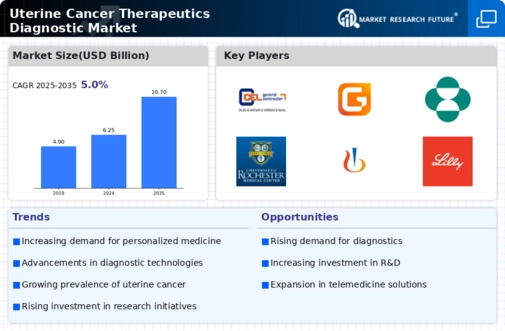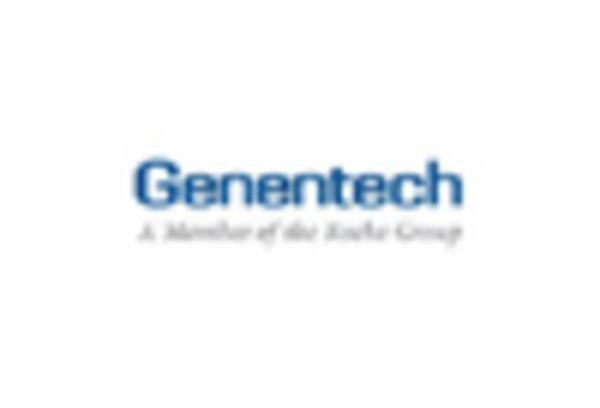Growing Incidence of Uterine Cancer
The rising incidence of uterine cancer is a pivotal driver for the Uterine Cancer Therapeutics Diagnostic Market. Recent statistics indicate that uterine cancer cases have been steadily increasing, with an estimated 66,570 new cases reported in 2021 alone. This alarming trend necessitates enhanced diagnostic tools and therapeutic options, thereby propelling market growth. As awareness of uterine cancer symptoms and risk factors expands, more individuals seek diagnostic services, further stimulating demand. The increasing prevalence of obesity and diabetes, both significant risk factors for uterine cancer, also contributes to this upward trajectory. Consequently, healthcare providers are compelled to invest in advanced diagnostic technologies to improve early detection and treatment outcomes, thereby fostering a robust market environment.
Advancements in Diagnostic Technologies
Technological innovations in diagnostic methodologies are significantly influencing the Uterine Cancer Therapeutics Diagnostic Market. The advent of advanced imaging techniques, such as MRI and PET scans, alongside molecular diagnostics, has revolutionized the detection and characterization of uterine cancer. These technologies enable earlier and more accurate diagnoses, which are crucial for effective treatment planning. Moreover, the integration of artificial intelligence in diagnostic processes is enhancing the precision of uterine cancer detection, potentially reducing false positives and negatives. As these technologies become more accessible and affordable, healthcare facilities are increasingly adopting them, thereby driving market growth. The continuous evolution of diagnostic tools is expected to further enhance patient outcomes, making this a critical driver in the industry.
Increased Investment in Cancer Research
The surge in investment directed towards cancer research is a significant catalyst for the Uterine Cancer Therapeutics Diagnostic Market. Governments and private organizations are allocating substantial funds to explore innovative diagnostic and therapeutic solutions for uterine cancer. For instance, the National Cancer Institute has reported a consistent increase in funding for cancer research initiatives, which includes studies focused on uterine cancer. This influx of capital not only accelerates the development of new diagnostic technologies but also fosters collaborations between research institutions and healthcare providers. As a result, the market is likely to witness the introduction of novel diagnostic tools and therapies, enhancing the overall landscape of uterine cancer management. This trend underscores the importance of sustained investment in research to drive advancements in the industry.
Rising Awareness and Education Initiatives
The growing awareness surrounding uterine cancer and the importance of early detection is a crucial driver for the Uterine Cancer Therapeutics Diagnostic Market. Educational campaigns aimed at both healthcare professionals and the general public are increasingly emphasizing the significance of recognizing symptoms and seeking timely medical intervention. Organizations dedicated to women's health are actively promoting screening programs and educational resources, which are likely to lead to higher rates of diagnosis. This heightened awareness not only encourages individuals to pursue diagnostic testing but also influences healthcare policies to prioritize uterine cancer screening. As more people become informed about the risks and available diagnostic options, the demand for uterine cancer diagnostics is expected to rise, thereby propelling market growth.
Regulatory Support for Diagnostic Innovations
Regulatory bodies are playing an instrumental role in shaping the Uterine Cancer Therapeutics Diagnostic Market by facilitating the approval and adoption of innovative diagnostic solutions. Streamlined regulatory processes and supportive policies are encouraging the development of new diagnostic technologies, which are essential for effective uterine cancer management. For instance, the FDA has introduced initiatives aimed at expediting the review of breakthrough diagnostic devices, thereby fostering innovation in the market. This regulatory support not only enhances the speed at which new technologies reach the market but also instills confidence among investors and manufacturers. As a result, the industry is likely to experience a surge in the introduction of advanced diagnostic tools, ultimately improving patient outcomes and driving market expansion.


















Leave a Comment